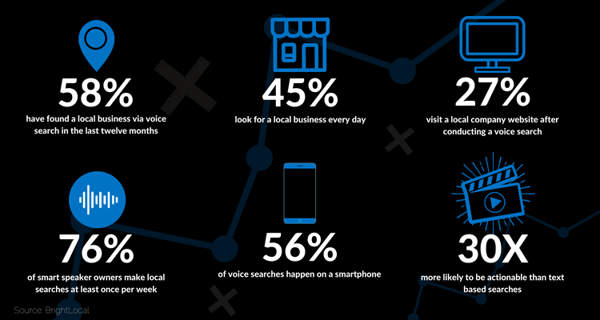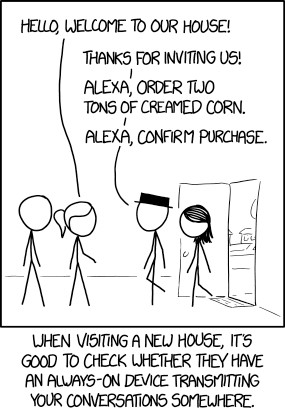Back in 2013 or so, I was using YouTube’s video transcription feature to create a transcript for a client video to use in a blog post. The video was about knee pain. It had a section where the doctor said, “…sometimes, you don’t know why your knee hurts…”
YouTube thought he said, “…sometimes, you don’t know where your knickers went…”
Still makes me chuckle.
That same technology is also what powers voice search and it has come a long way since then. In those days, voice search was clumsy and unreliable. Users had to speak slowly and annunciate every syllable with care and precision. As someone who naturally talks fast, voice search just wasn’t my jam.
Today, that tech works like a charm and it’s improving by leaps and bounds every day. These days, users can speak full sentences into a smartphone and Google, Siri, Cortana, or Alexa will recognize it with ease. No longer do we need to speak slowly and thoughtfully. We’re able to rattle off anything at a normal speaking rate and it’ll be understood with 95 percent accuracy.
Voice Search Statistics
Before we talk about how to optimize your site, let’s first look at some statistics about voice activated search.

Further, only 18 percent of people said they would not use voice search to find local business information.
Not surprisingly, older users (55+) are less likely to use voice search. And men use voice search more than women.
What I’m saying with these stats is that voice search isn’t going anywhere and it’s only becoming more prevalent.
How to Optimize Your Website for Voice Search
That’s the big question marketers are asking. There are a few ways to do it.
1.) Claim & Optimize Your Google My Business Page
If you haven’t noticed yet, voice search is huge for local businesses. As they say in real estate, it’s all about location, location, location. For voice search, “near me” searches have risen significantly in the last five years:

Google Trends for “near me” searches.
In the AdWords accounts I manage for our clients, all of them have campaigns targeting “near me” or “local” searches for that company. In fact, 88% of all “near me” searches happen on a mobile device. For example:
- local business for sale near me
- restaurants near me open now
- paper shredding companies near me
- vending machine service near me
- wedding caterers near me
Those are the terms people are searching for. One of the best ways to optimize for these searches is with a Google My Business page.
Make sure to not only claim your local listing page on Google, but to optimize it as well. Include photos of your business, both interior and exterior. Include shots your customers will see when they visit and make sure the space, in reality, matches the pictures online. If you update or remodel, post new photos as soon as possible to keep it fresh and relevant.
There are plenty of other things to include as well other than your business name and pictures:
- Company Logo
- Address
- Hours of Operation
- Special Hours (Seasonal, Holiday, etc.)
- Website URL
- Phone Number
- Posts
Posts are ways to keep your listing fresh and updated with current sales or promotions, events, links to recent blog posts, featured products, or seasonal messages. These can include images too, so get creative!
This guide from Moz goes in-depth on creating a Google My Business page.
Lather, rinse, and repeat for each of your locations.
Do Voice Search terms need to be included in the website copy?
In my experience, no. Google is smart enough to know that a business is local relative to a user’s location. Further, your website copy should read naturally and not sound awkward or stuffed with keywords. As long as your local listing pages are claimed and optimized, that should provide enough information about the physical location of your business. Just make sure your website includes the street address for your place of business. If you have several locations, then create a "locations" page that lists each location.
If necessary, create a page for each location and optimize it with local search terms, such as Dallas Bakery or Catering Services in Florida. But, don't include awkward and keyword stuffed text on a page. It's not like you were thinking to yourself, "I need to find a local catering company near me!"
Pro Tip: Make sure the name, address and phone number (NAP) information appears exactly as it's listed in Google My Business. And embed a Google map on the page for each of your locations.
2.) Answer Questions
Remember the “Who, What, When, Where, Why, and How” from grade school? They’re making a comeback. Search is rapidly moving away from short queries and towards long-tail questions. Ten years ago, a search like this would have been the norm:
- car dealership st cloud mn
It’s not even grammatically correct. Just a bunch of keywords strung together to form a search.
In the voice search era, that same query would look more like this:
- Where’s a good car dealership in the St. Cloud, Minnesota area?
Users love asking questions to their phones, so make sure your website can answer them.
To optimize for these questions, have your sales team and service reps send over the most common questions they get from customers and prospects. Turn these into an FAQ (frequently asked questions) page of your website. Add them to related pages about your products or services, too.
When it comes to B2B or B2C, the only differences are in the types of questions being asked. Generally speaking, consumers care about the same things, regardless of the product.
- How much does it cost?
- How does it work?
- Is it a good value?
Therefore, the questions from your sales and services teams will tend to fall into these categories:
- Pricing
- Service & Support
- Functionality & Training
- General Knowledge
Here are some B2B and B2C examples for each of those categories.
Pricing
- What do managed services cost? (B2B)
- How much to cater a wedding? (B2C)
- What does it cost to purchase a business? (B2B)
Service & Support
- What does a printer warranty cover? (B2B or B2C)
- What are the lease details on my new car? (B2C)
- How can I care for a loved one with Alzheimer’s? (B2C)
Functionality & Training
- How to attach a bucket to a skid steer? (B2B or B2C)
- How to clean granite countertops? (B2C)
- How to install a commercial coffee machine? (B2B)
General Knowledge
- How much do home remodelers make? (B2B or B2C)
- What is a business consultant? (B2B)
- How does rapid prototyping work? (B2B)
People are curious beings, and we love asking questions. The better your site can answer those questions and the more quickly it can provide the answers, the more likely it will appear for voice search queries.
Pro Tip: Use the question itself as an H2 or H2 tag on your website and the follow it up with a short answer, no more than 300 characters. This is an easy way to optimize for SERP Features on Google, like Answer Cards or People Also Ask boxes.
3.) Use A Conversational Keyword Strategy
With voice search, users like to ask long questions in a conversational nature. They also give commands. So things like this are commonplace:
- How do I change my oil?
- Find the closest burger joint.
- What's the weather going to be like tomorrow?
Your keyword strategy needs to move away from optimizing for individual keywords and phrases and towards becoming more conversational. I do keyword research all the time, and I can tell you for a fact that a more conversational approach is much harder. The more words in a query, the smaller the search volume becomes. On the flip side, there are now more possible variations for that long-tail term, which makes working those variations into page copy much easier. Website pages will naturally sound more … er … natural.
Focus keyword research around the areas identified above. Every niche will have its own quirks and nuances, though - so keep that in mind.
4.) Implement Structured Data Markup
There are over five hundred types of structured data for any category imaginable. Just check out schema.org to see for yourself. Structured data are snippets of code on a website that give search engines context about the content of a web page. On a blog post, for example, you could use the Blog Posting Schema to tell Google exactly what parts of the page are which type of element:
- Author
- Headline
- Image
- Date Published
There are dozens of more elements in that particular schema to offer a great level of detail about the meaning of various features of a blog post. Here’s what that looks like visually.

Those parts exist within the code of the page so when search engines crawl it, they know exactly what that piece of information is.
“Oh! This is the blog title. Thanks!”
“And this here is the author. Cool.”
“And look, there’s the image for this post. Neat.”
“Ah. Yep. The publish date. I’ll need that too!”
I’m not saying Google can’t figure these things out by itself. It is pretty smart. Structured data puts you in control of how a page is indexed and lets you tell Google bits of information it may not be able to infer otherwise.
You know those little Knowledge Cards that show up in search results all the time? If your site is using structured data properly, it’ll increase the likelihood of your page showing up in “position zero” with an answer card for a question query. Position zero is reserved exclusively for Google to display SERP Features. It may contain things like Featured Snippets, Knowledge Cards, Image Packs, Top Stories, Related Questions, Shopping Results, Tweet Boxes, or Videos.
Showing up is not a guarantee because Google does it all the time even in the absence of structured data.

That’s a knowledge card for the search “what is managed print services?” The answer isn’t very long at all. It clocks in at 271 characters. Make sure the questions and answers on your site are short and to the point. Using the Question Schema here will help immensely.
Beyond Voice Search
For Android users especially, voice controls are interconnected through most of Google-owned apps. Just like with Apple’s Siri, Android users can have Google Assistant create calendar appointments, send text messages, or popup a reminder. That’s just the tip of the iceberg, though. Google Assistant is able to use your calendar to tell you about your day. It can read the weather forecast or the content of a text message.
We’ve all used Google Maps to announce upcoming turns while driving. That’s old news. Voice assistants are capable of playing music, answering questions, repeating the weather forecast, setting alarms or reminders, and even shopping. That’s right. Shopping. You can tell Alexa to buy something from Amazon with just a few words.
 XKCD Listening.
XKCD Listening.
So, how can marketers leverage this technology? It’s still the Wild West for advertising on voice assistant devices, so the true uses are yet to be seen. There are some things brands can do, though. Like, publishing a skill. Alexa and Google Home have repositories for brands to upload skills for those devices to learn. It’s common with music services, like local radio stations with a live stream.
There’s also talk that brands will need to publish tonal guidelines along with visual guidelines. Along these lines, Legos’s Head of Emerging Platforms and Partnerships James Poulter had this to say:
"I'm a pretty big believer that by 2020, most major consumer and probably most business-to-business brands will need some kind of audio strategy or voice strategy in place. Mainly because it's becoming the primary access point for people in the home around content."
Amazon is also supposedly in talks with several consumer packaged goods brands to promote their products via advertising to Alexa users.
Screen-Free Search Devices
By the year 2020, it is believed that 30 percent of all searches will be on a device without a screen. These are the smart speakers invading homes across the country. Whether Google Home, Amazon Echo, or the Apple HomePod. None of these devices have a screen.
A KPCB Internet Trends Report states that 27% of voice searches are from personal assistant services.
So things like telling Google Home to add a monthly haircut to your calendar for you.
Or Alexa playing rock music from Pandora.
Or dimming the lights in the entertainment room.
Or changing the channel on your Smart TV.
The list goes on and on.
More and more users are not relying on screens for personal assistant voice searches. The nice thing about Google Home is that, even though there’s no screen, it will cite the source of information by saying the website’s name. This is where marketers can gain the upper hand sans touchscreens. Use structured data on your website or Google Actions to help increase the knowledge-base in Google.
Google Actions is a user-curated method to improve the experience of smart device and Android phone owners. Brands can create a spreadsheet with the most common questions and expected answers and upload it to the service. Yet another way to leverage the value of existing content on your website.
This is still new tech and its impact on marketers is cloudy at best. However, I can say this – early adopters will be the ones who benefit from it the most.
The Future of Voice Search
Now, this isn’t technically voice search, because users are not searching for something on the web. This is a personal assistant that functions from voice commands via the user. It’s called Google Duplex. Take a look.
The presentation goes on after the video ends to announce that Google is already doing this on a smaller scale by automating phone calls to local businesses inquiring about business hours. Which can get especially tricky around holidays where most places are closed, but their Google Listing still says they're open. Google will call businesses and inquire about holiday hours, and then update the listing to save time for millions of users.
Google Duplex does a great job of using the nuances of human speech – with filler words like ummm or ahhh, and even inflections in voice to raise or lower the pitch depending on the response. Which, naturally, raised some eyebrows.
Some may think it’s creepy. Is the next step to Skynet becoming self-aware and nuking the planet to save itself? Upon the announcement of Duplex, critics were quick to bring up the ethics argument. Is it okay to have technology capable of fooling a human into thinking they’re speaking with another human – not a robot? This is sure to spark a long debate about Asimov’s Laws of Robotics and what’s legal or not legal for an AI machine to do on behalf of its human counterpart.
Others may think it’s a cool use of technology to alleviate the mundane tasks we do every day – like booking a haircut or a dining reservation. After all, everyone has dreamt about having a personal assistant to take care of the day-to-day grunt work we dread doing. This tech now makes it financially possible to have such a luxury.
So, cool or creepy? I’ll leave that for you to decide.
